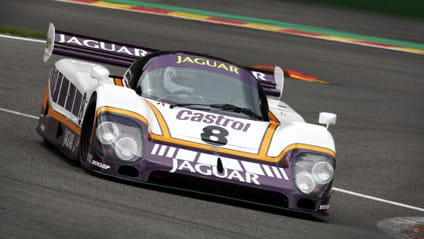
These classic racing Jags are the best things you'll see today
With Jaguar competing in Formula E, we look back at the company's racing highlights


Jaguar is making a comeback to motorsport via Formula E, having not been directly involved in competitive racing since departing Formula One in 2004.
The opportunity for the British manufacturer - which is owned by Indian company Tata Motors – to test batteries and drivetrains in an electric series makes Formula E a logical proposition for Jaguar, which is likely to venture into the electric car market in the near future.
While many people hold a sceptical view of Formula E, the news that the UK has pledged to stop production of vehicles with any sort of emissions coming from the tailpipe by 2050 shows there is a pressing need to develop alternative solutions for road-going cars.
And if Jaguar’s past is anything to go by, there’s no reason they can’t make it work. They won Le Mans several times in the 50s and have enjoyed scores of other successes. One of which of course, was creating some rather lovely racing machinery.
With that in mind, there’s no better opportunity to quickly revisit some of those highs...
Advertisement - Page continues belowJaguar C-Type

Where it all began. The C-Type won Le Mans at the first time of asking in 1951 with Peters Walker and Whitehead behind the wheel, although it missed out on defending its title in 1952 as all three entries failed to finish.
It regained its crown a year later though, with Duncan Hamilton and Tony Rolt taking victory with an average speed of over 100mph; the first time this had ever been achieved.
Jaguar D-Type

The second part of Jaguar’s domination of the 50s, winning the Sebring 12 Hours in 1955 and Le Mans three times on the spin from ‘55 to ’57.
Jaguar’s factory team actually pulled out of the event at La Sarthe in 1956 having lost to the D-Types entered by Scottish team Ecurie Ecosse, who subsequently ran them again in 1957. The one-two finish that year was the D-Type’s best result.
Advertisement - Page continues belowJaguar E-Type

Another step down the alphabet to one of the prettiest cars ever made. It won the 1963 GT Championship under the command of Bob Jane, who was driving a lightweight version of the car.
The E-Type also featured at Le Mans and Sebring, but was never intended as an out and out racer, and failed to reproduce the success of its predecessors.
Jaguar XJ13

Developed by Jaguar for endurance racing in the mid 60s, the XJ13 never actually made it to the racetrack.
The aluminium body was designed by Malcolm Sayer – the man behind the C-Type, the D-Type, the E-Type and the XJS – but testing revealed the car would need a lot of work to make it competitive.
After being shelved, the XJ13 was crashed during testing in 1971. It was repaired and finally revealed to the public at the British Grand Prix at Silverstone two years later.
Jaguar XJR-9

Made a victorious debut at the 24 Hours of Daytona in 1988, going on to finish third in the IMSA Camel GT series that season. Also won the World Sports Prototype Championship that year with Martin Brundle part of the winning Jaguar team, taking six wins, including victory at Le Mans.
Its success was curtailed as other manufacturers caught up, forcing Jaguar to bring in the XJR-10 and XJR-11 in 1989. It did eventually win at Le Sarthe, though – at the Le Mans Legends race in 2010.
Jaguar XJ220

Originally a road car, a racing version named the XJ220-C was produced in 1993. It raced at Le Mans that year in the newly introduced GT class, with David Coulthard, David Brabham and John Nielsen taking victory ahead of Porsche.
The win didn’t stand for very long though, as a technicality saw them disqualified from the race. Jaguar successfully argued against the punishment, but it was upheld anyway on account of the appeal being submitted late.
Advertisement - Page continues belowJaguar XJR-15

Built specifically for the Jaguar Sport Intercontinental Challenge in 1991, a support series which featured at Grands Prix in Monaco, Silverstone and Spa.
A $1,000,000 prize was offered for 1st place in the final, forcing organizers to conceal the length of the race in response to rumours of result fixing among drivers.
Armin Hahne eventually took the chequered flag after 11 laps, beating Cor Euser and Win Percy into second and third respectively.
Jaguar Racing F1

Possibly Jaguar’s least successful motorsport venture. Then owned by Ford, Jaguar bought the Stewart Grand Prix team formed by three time world champion Jackie Stewart at the end of 1999.
Rebranded as Jaguar, they endured five unhappy seasons which yielded just two podium finishes despite the efforts of Eddie Irvine and Mark Webber among others.
The team was sold to Dietrich Mateschitz and renamed Red Bull Racing in 2005. Five years after Jaguar’s departure, they became world champions. Then did it again. And again. And again.
Advertisement - Page continues below
Trending this week
- Car Review
BMW 1 Series
- Top Gear's Top 9
Nine dreadful bits of 'homeware' made by carmakers







